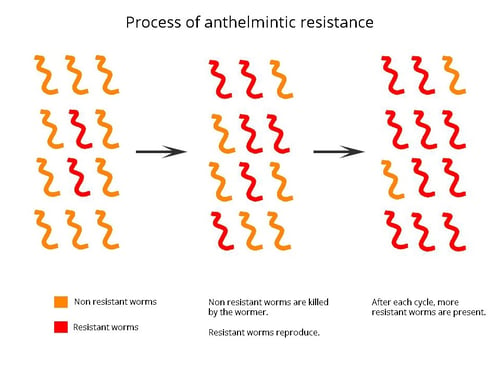Following on from our previous blog on “Getting your worming strategy right”, we are now taking a look at the different types of cattle wormers and what you can do your to prevent anthelmintic resistance on your farm.
There are a range of different products available for the treatment of gut worms, lung worms and liver fluke. However, the broad spectrum products fall into three different categories.
- White drenches, or Benzimidazoles
- Yellow drenches, or Levamisoles
- Clear drenches, or Macrocyclic lactones

What does worm resistance look like?
A full effective worm treatment should reduce the egg count to zero after administration of the dose. If the egg count reduction is less than 95% after treatment, then worm resistance is present on your farm.
How do I know if my wormer is effective or if I have a resistance problem?
Take faecal sample from cattle 14 days (7 days for levamisole’s) after treatment to determine how effective the product is.
Avoiding buying in cattle with resistant worms
Buying in new stock without effective quarantine treatments is a major contributor to the appearance of wormer resistance on your farm. You should assume that all bought in cattle have some degree of wormer resistance, and as such should be quarantined and treated with a product that is effective on your farm.
Cattle should be held off grass for 48 hours after treatment until any worm eggs present in the gut have been passed out in the faeces.
Return cattle to previously or partially grazed fields
After treatment, turn out cattle to fields that has been previously grazed by your cattle in the same grazing season. This will help ensure that any resistant worms passed out by the new stock are outnumbered by the hopefully none resistant resident worms.
Dose to the heaviest animal in the group
Always ensure you are not under dosing cattle as this can lead to ineffective treatment and worm resistance. Weigh your heaviest animal and dose the other animals to that weight unless there are big differences in the weight. Then split the group into two and dose to the heaviest in the lighter group.
Think about spot dosing cattle.
Some animals may not need dosing. If some animals in a group are performing visibly better than others they probably do not need to be treated.
Alternatively, if some animals are underperforming compared to the rest of the group, it might be worthwhile doing a faecal sample test to ensure that parasites are the cause of this and it is not some other factor.


